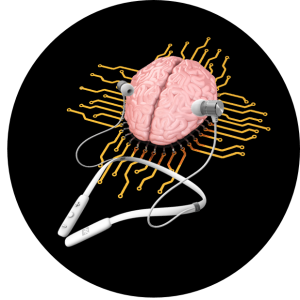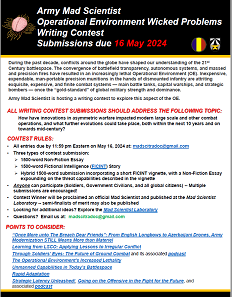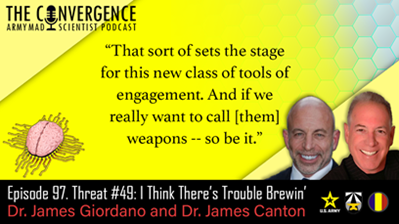“That sort of sets the stage for this new class of tools of engagement. And if we really want to call [them] weapons — so be it.”
[Editor’s Note: Humanity is entering an era of hyper-innovation as the potential of Big Data, Artificial Intelligence, and Neurocognitive Sciences are harnessed to revolutionize human endeavors. As these exponential convergences of technologies spin ever faster cycles of adaptation and innovation, the quest for dominance and advantage will favor those who jettison outdated industrial age processes and implement (and resource!) whole-of-nation strategies integrating private and public sector science and technology enterprises.
In today’s episode of The Convergence podcast, our “rock star” proclaimed Mad Scientists — Dr. James Giordano and Dr. James Canton — return to discuss the transformative convergence of neuroscience and artificial intelligence and its implications for the Operational Environment — Read on!]
[If the podcast dashboard is not rendering correctly for you, please click here to listen to the podcast.]
 Proclaimed Mad Scientist Dr. James Giordano is Pellegrino Center Professor in the Departments of Neurology and Biochemistry; Chief of the Neuroethics Studies Program; and Chair of the Subprogram in Military Medical Ethics at Georgetown University Medical Center, Washington, DC. Dr. Giordano is a Bioethicist of the Defense Medical Ethics Center at the Uniformed Services University of Health Sciences; Distinguished Stockdale Fellow in Science, Technology, and Ethics at the United States Naval Academy; Senior Fellow in Biosecurity, Technology, and Ethics at the U.S. Naval War College, Newport, RI; Senior Science Advisory Fellow of the Strategic Multilayer Assessment (SMA), Joint Staff / J-39, The Pentagon; Chair Emeritus of the Neuroethics Project of the Institute of Electrical and Electronics Engineers (IEEE) Brain Initiative; and serves as Director of the Institute for Biodefense Research, a federally funded Washington, DC, think tank dedicated to addressing emerging issues at the intersection of science, technology and national defense. He previously served as Donovan Group Senior Fellow, U.S. Special Operations Command; member of the Neuroethics, Legal, and Social Issues Advisory Panel of the Defense Advanced Research Projects Agency (DARPA); and Task Leader of the Working Group on Dual-Use of the EU-Human Brain Project.
Proclaimed Mad Scientist Dr. James Giordano is Pellegrino Center Professor in the Departments of Neurology and Biochemistry; Chief of the Neuroethics Studies Program; and Chair of the Subprogram in Military Medical Ethics at Georgetown University Medical Center, Washington, DC. Dr. Giordano is a Bioethicist of the Defense Medical Ethics Center at the Uniformed Services University of Health Sciences; Distinguished Stockdale Fellow in Science, Technology, and Ethics at the United States Naval Academy; Senior Fellow in Biosecurity, Technology, and Ethics at the U.S. Naval War College, Newport, RI; Senior Science Advisory Fellow of the Strategic Multilayer Assessment (SMA), Joint Staff / J-39, The Pentagon; Chair Emeritus of the Neuroethics Project of the Institute of Electrical and Electronics Engineers (IEEE) Brain Initiative; and serves as Director of the Institute for Biodefense Research, a federally funded Washington, DC, think tank dedicated to addressing emerging issues at the intersection of science, technology and national defense. He previously served as Donovan Group Senior Fellow, U.S. Special Operations Command; member of the Neuroethics, Legal, and Social Issues Advisory Panel of the Defense Advanced Research Projects Agency (DARPA); and Task Leader of the Working Group on Dual-Use of the EU-Human Brain Project.
Dr. Giordano is the author of 340 peer-reviewed publications, 7 books, and 45 governmental reports on science, technology, and biosecurity, and is an elected member of the European Academy of Science and Arts, a Fellow of the Royal Society of Medicine (UK), and a Fulbright Professorial Fellow. A former U.S. Naval officer, he held designations as an aerospace physiologist and research psychologist, and served with the U.S. Navy and Marine Corps.
 Proclaimed Mad Scientist Dr. James Canton is a global futurist, social scientist, author, and strategic advisor. As a former Apple Computer executive and high-tech entrepreneur, he has been insightfully forecasting the key trends and technologies that have shaped our world, including AI-nano-bio-IT-neuroquantum-
Proclaimed Mad Scientist Dr. James Canton is a global futurist, social scientist, author, and strategic advisor. As a former Apple Computer executive and high-tech entrepreneur, he has been insightfully forecasting the key trends and technologies that have shaped our world, including AI-nano-bio-IT-neuroquantum-
cloud. The Economist recognizes him as one of the leading global futurists. He has advised three White House Administrations, the DoD, Intelligence Community, and over 100 companies over 30 years. Dr. Canton is CEO and Chairman of the Institute for Global Futures, a leading think tank he founded in 1990 that advises business and government.
Dr. Canton is the author of Future Smart, The Extreme Future: The Top Trends That Will Reshape the World in the Next Twenty Years, and Technofutures: How Leading-Edge Innovations Will Transform Business in the 21st Century. Dr. Canton has been a lecturer at Stanford University, the Wharton School of the University of Pennsylvania, New York University, the U.S. Army and Naval War Colleges, and the Joint Special Operations University. He has held appointments at Singularity University at NASA, the Kellogg School of Management, MIT’s Media Lab, EU, the Potomac Institute, and served on the International Advisory Council, Singapore Economic Development Board, and been an advisor to the National Science and Technology Council and the U.S. Departments of State, Defense, and Health and Human Services.
In our latest episode of The Convergence podcast, Army Mad Scientist sits down with our “James Gang” — Dr. James Giordano and Dr. James Canton — to discuss a new threat that combines neuroscience and artificial intelligence. The following bullet points highlight key insights from our conversation:
-
-
- Big Data is underpinning advances in both neurocognitive sciences and artificial intelligence – especially machine learning and deep learning. The
 exponential convergence of technologies (Nanoscience and Nanotechnology, Biotechnology and Biomedicine, Information Technology, Cognitive Science and Neuroscience, and Quantum Science) is leading to revolutionary achievements – we’re on the cusp of realizing neuromorphic chips that mimic brain function.
exponential convergence of technologies (Nanoscience and Nanotechnology, Biotechnology and Biomedicine, Information Technology, Cognitive Science and Neuroscience, and Quantum Science) is leading to revolutionary achievements – we’re on the cusp of realizing neuromorphic chips that mimic brain function.
- Big Data is underpinning advances in both neurocognitive sciences and artificial intelligence – especially machine learning and deep learning. The
-
-
-
- The private sector has made significant leaps forward in the advancement of big data, synthetic intelligence, and neuroscience, while the Government is just now catching up to integrating the convergence of these technologies into our capabilities.
-
-
-
- We are currently in an era in which innovation is happening near simultaneously, facilitated by the exploitation of entirely new kinds of artificial intelligence. “AI
 time” is infinitely collapsible – computing time has become exponentially quicker than human labor. Large Language Models and pattern recognition algorithms are revolutionizing creativity and innovation across all human endeavors, including competition and conflict.
time” is infinitely collapsible – computing time has become exponentially quicker than human labor. Large Language Models and pattern recognition algorithms are revolutionizing creativity and innovation across all human endeavors, including competition and conflict.
- We are currently in an era in which innovation is happening near simultaneously, facilitated by the exploitation of entirely new kinds of artificial intelligence. “AI
-
-
-
- Due to the rapid pace of science and technology advancements and convergences, we must be on the other side of perfect — better is truly the enemy of good enough! Twentieth century industrial age processes taking multiple years or even decades to yield exquisite and expensive capabilities are no longer viable in an era of rapid adaptation — we will compete and fight in an Operational Environment where adversarial systems will be smaller, faster, cheaper, and more disposable. Moore’s Law is out – instead of 18 months for advancements to double, it’s now 18 days.
-
-
-
-

China’s “triple helix” achieves synergy via cooperative engagement across government, academia, and commercial sectors that allows for the centralization and coordination of resources and personnel on agenda, and projects of prime national interest. Our previous fights have been asymmetrical — the next war will be far more symmetrical as advances in science and technology continue. While our international peer competitors have well-defined strategic scientific and technological plans, the U.S. lacks a strategic plan of the same caliber. A whole-of-nations approach is necessary to define a unified government posture and strategic plan for science and technology, married to a governmentally-sponsored effort to join the research and commercial communities to realize this plan -– absent this, we will fail.
-
-

Stay tuned to the Mad Scientist Laboratory for our next episode of The Convergence on 16 May 2024, featuring Shawn Nilius, Director, Army OSINT Office, discussing why OSINT is important to the Army, how it is being used in contemporary operations, and how he sees it evolving over the next 10 years!
If you enjoyed this post and podcast, check out our previous pairing featuring Mad Scientist’s “James Gang” — One Brain Chip, Please! Neuro-AI with two of the Maddest Scientists and associated podcast
… review the following related content:
Speed, Scope, and Convergence Trends
There Will Be Data and associated podcast, with Dr. Inderpal Bhandari
The AI Study Buddy at the Army War College (Part 1) and associated podcast, with LtCol Joe Buffamante, USMC
The AI Study Buddy at the Army War College (Part 2) and associated podcast, with Dr. Billy Barry, USAWC
Chatty Cathy, Open the Pod Bay Doors: An Interview with ChatGPT and associated podcast
Artificial Intelligence: An Emerging Game-changer
Takeaways Learned about the Future of the AI Battlefield and associated information paper
Integrating Artificial Intelligence into Military Operations, by Dr. James Mancillas
“Own the Night” and the associated Modern War Institute podcast, with proclaimed Mad Scientist Bob Work
The Operational Environment’s Increased Lethality
WMD Threat: Now and in the Future
The Hard Part of Fighting a War: Contested Logistics
Unmanned Capabilities in Today’s Battlespace
Revolutionizing 21st Century Warfighting: UAVs and C-UAS
… then crank up the original James Gang‘s Funk #49 !
>>>>REMINDER: Army Mad Scientist wants to crowdsource your thoughts on asymmetric warfare — check out our Operational Environment Wicked Problems Writing Contest.
All entries must address the following topic:
How have innovations in asymmetric warfare impacted modern large scale and other combat operations, and what further evolutions could take place, both within the next 10 years and on towards mid-century?
We are accepting three types of submissions:
-
-
- 1500-word Non-Fiction Essay
-
-
-
- 1500-word Fictional Intelligence (FICINT) Story
-
-
-
- Hybrid 1500-word submission incorporating a short FICINT vignette, with a Non-Fiction Essay expounding on the threat capabilities described in the vignette
-
 Anyone can participate (Soldiers, Government Civilians, and all global citizens) — Multiple submissions are encouraged!
Anyone can participate (Soldiers, Government Civilians, and all global citizens) — Multiple submissions are encouraged!
All entries are due NLT 11:59 pm Eastern on May 16, 2024 at: madscitradoc@gmail.com
Click here for additional information on this contest — we look forward to your participation!
Disclaimer: The views expressed in this blog post do not necessarily reflect those of the U.S. Department of Defense, Department of the Army, Army Futures Command (AFC), or Training and Doctrine Command (TRADOC).



